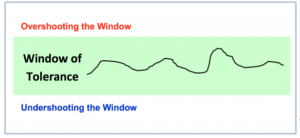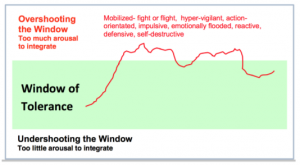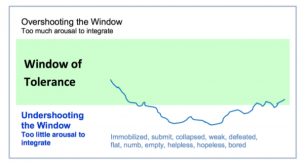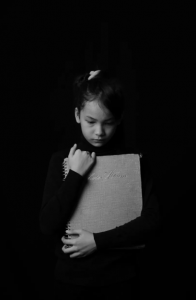3.5 The window of tolerance
Every individual has what is known as a ‘window of tolerance’. This means that there is a state of physical and emotional arousal that is tolerable and bearable, and when a child is within his or her window of tolerance, she or he can think, learn, love and relax. Most people can identify times when they have been outside the boundaries of their window of tolerance. At these times thinking or behaviour has become disrupted by intensified emotional and physiological arousal. Behaviours during these times are not normally chosen, and a lack of flexibility in responses is common. Either excessive rigidity or chaos are typical during these dysregulated episodes.

For traumatised children, small ‘every day’ things (like a parental request to brush their teeth, or a change of one classroom to the next) spirals them out of their window of tolerance. Traumatised children then swing into being hyper-aroused (overly aroused) or hypo-aroused (under aroused). You can expect traumatised children to be over or under aroused for most of the time and, in either state, their behaviour is out of their hands; they simply cannot control it no matter how hard they try. Their brain is not wired correctly and they do not have the ability to switch off behaviour. They are in automatic survival mode and they cannot think, reason or rationalise when feeling under threat.
overshooting the window: Hyperarousal
Many traumatised young people have difficulty finding stillness. You might have noticed their darting eyes and a tendency to fiddle with something in their hands or how easily they startle. You might even notice yourself feeling a little stirred up or ill at ease when around them. You notice this because their internal system that is primed to act to protect itself is communicating with your nervous system. These young people are likely to engage in actions such as fight or flight in the face of threat. We can expect them to move toward or away when they feel unsafe. These protective actions are deeply ingrained in the most primitive part of their brains and they have likely been used successfully in the past by the young person to help keep themselves safe.

Children who are overly-aroused are in fight/flight. They run, hit, scream, shout, bite, spit, say hurtful words, avoid, squirm and disrupt. The brain says, “I’m in danger” and their body responds. Some physical cues suggesting too much arousal and an overshooting of the window of tolerance include:
- dilated pupils (to let light in to see better)
- lack of saliva making the mouth dry
- shallow breathing
- butterflies in the stomach
- faster heart beat
- excessive sweating
- tensed muscles (readied for action)
- agitated movement
- difficulty finding stillness.
![]()
Case example – Gary
The bell sounds ending lunchtime. The teacher rushes towards her year nine class having missed lunch to handle a yard duty incident. Distracted and rushed she moves into the classroom and the students flow in behind her. As she sorts out her teaching materials two students begin throwing around a cap that one student has forgotten to remove after lunch. The teacher raises her head to spy her student Gary moving around the room trying to get his cap back. The teacher recognises the cap as Gary’s because he is always wearing it in the yard. She sighs to herself as she recognises Gary as a student that is frequently unsettled and unproductive in her classroom. The class has barely begun, and he is already in the middle of the disruption she thinks to herself. The teacher moves forward and says firmly “I’ll have that cap” and picks it up off the floor before Gary can dive for it. She announces that she will be keeping it until the end of the class as he is not supposed to have his cap in the classroom anyway. Gary squeals “that isn’t fair”. His chest puffs up and his eyes look wildly at her. His left fist tightens and the veins in his reddened neck become prominent. His face shows he is mad and his body seethes with anger as his arm and shoulder muscles tense. Without consciously thinking the teacher takes a step back from him. He yells at her, “I hate this f###ing school”. She replies, frustration tightening in her body “Gary that is not appropriate language”. Gary lunges towards his cap in the teacher’s hand. The teacher drops the cap with a sudden surge of fear. Gary scrapes it up from the floor and takes off out of the classroom.
Undershooting the window: Hypoarousual
Some traumatised young people have endured extremely high levels of trauma. These young people might describe feeling empty and hollow at times of high stress. They might lack a sense of themselves at these times and describe not feeling anything in their body. At these times, they are moving into a state of protection that involves shutting down their system to protect themselves. These young people will not seek interaction with others and instead will retreat into themselves to endure the moment through a fortification of withdrawal.

Under-aroused children experience ‘system shut down’. They go numb, dead inside, feel nothing, zone out, feel empty, cannot connect and cannot think. They are like an empty shell. In both over and under arousal the child’s heart rate is going as fast as a soldier’s in battle. Their appetite is reduced, their tummy hurts, they are in a sweat, they shake, and they are hyper-vigilant to every tiny little detail in their environment. Some physical cues suggesting too little arousal and an undershooting of the window of tolerance include:
- slumped posture

Black and white child by Brother’s photo licensed under CC0. - collapsed body
- endless stare with pin like pupils
- loose muscles
- slowed heart rate
- blank face
It can be helpful to remember that at the core of a trauma experience – is a loss of control. If children could stop their abuse, then they would. Traumatised children become experts at regaining the very control that they lost. Controlling behaviours often cause big challenges for adults. While the child does not know it, they are so often trying to resolve their primal feeling of being helpless in a punishing world.
![]()
Case example – Miranda
A teacher pauses as he goes to write Miranda’s “Health and Human Development‟ semester report. For most students reports flowed easily for him but with the lack of submitted work and a large amount of absences he noticed next to Miranda’s name in his attendance book he found himself struggling to find words for her. When he thought about her, the picture in his mind was of a shrunken, head lowered young person, hunched down in her chair at the back of the classroom. He found her really hard to read and he realised he had never seen her really smile like other kids. He recalled a difficult moment that occurred some time ago when he called upon her to answer a question after showing a sex education video to the class and how response-less she had been, just vacantly sitting there, face blank and slumped down in her chair. He had quickly called upon another student as he had felt a sense of disconnect and awkwardness. He felt a bit exasperated when he thought about her and didn’t know what to do with her, how to engage her, nothing seemed to touch her. From what he understood Miranda was involved quite a bit with the school counsellor and he imagined she had a difficult home life. He wasn’t sure about the best way to teach Miranda, but he knew something needed to change as presently not much was getting through to her.
Operating within the window of tolerance
When within their window of tolerance, a young person’s physiological system is not stretched. They won’t feel signs of fight, flight, freeze or collapse as their systems sense that they are safe. In their window of tolerance social engagement is available to them. They are better equipped to listen to others around them, interact cooperatively and learn. Some cues suggesting young people are in their window of tolerance:
- Body feels calm, settled, neutral
- Able to be socially orientated with those around them
- Able to be reflective
- Able think clearly
- Able to set boundaries
- Able to self-regulate
- Able to be mindful
Recognising those that overshoot and undershoot the window of tolerance in the classroom
Effective educational programs work to keep everyone within the window of tolerance optimal arousal zone. It is often easier to recognise those young people in the classroom who overshoot their window of tolerance compared with those who undershoot. These are likely to be the students who show their stress by moving towards or away from you. This movement is highly visible as we are biologically primed as social beings to notice others threatened movements to then gauge our own safety. For overshooting students looking to find safety, this involves an active re-negotiation of relationships, while for those who undershoot their window, seeking safety often involves slipping away from others in a passive attempt to find invisibility for a time. These students do not demand a response from others. In fact, they are working hard to be overlooked and with 24 or so other students in the classroom it is easy to not spot them.

